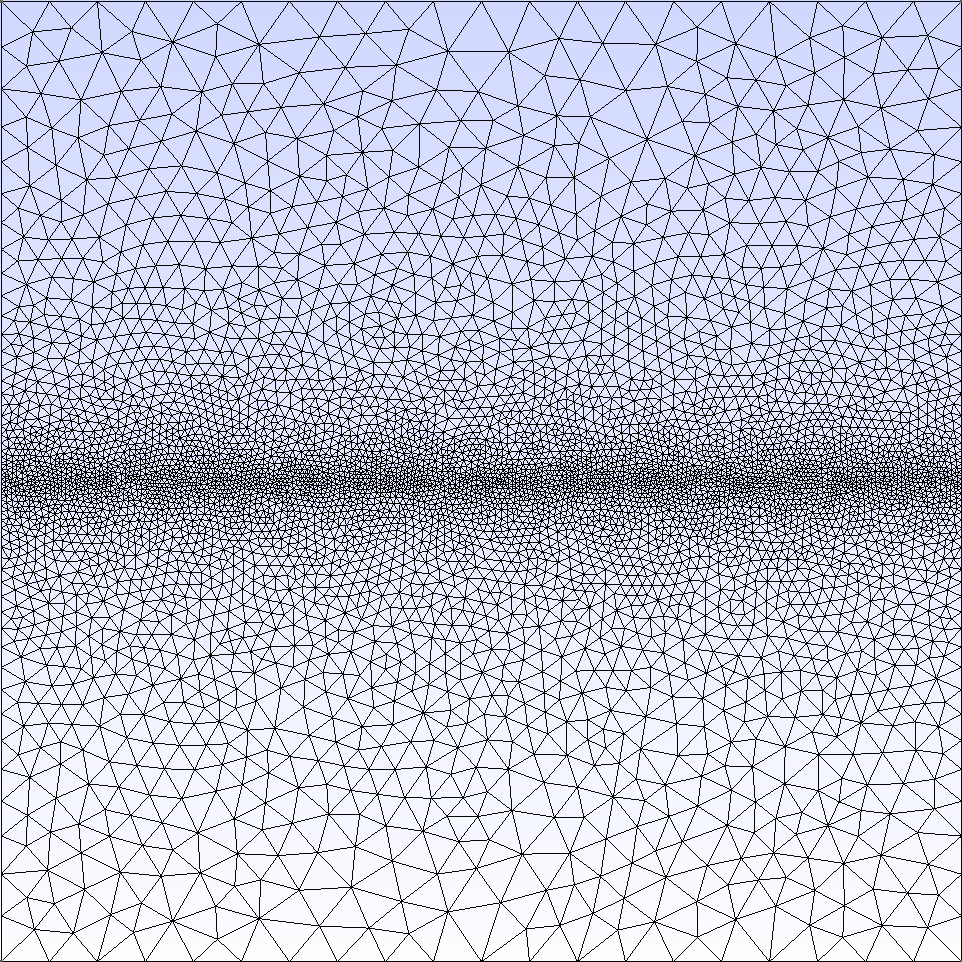Python wrappers to gmsh files with object-oriented syntax
Project description
py2gmsh
Python wrappers to create gmsh files with object-oriented syntax.
The wrappers are made closest to actual gmsh syntax for .geo files, with the addition of convenience tools, object-oriented syntax for easy manipulation and extra functionalities.
Installation
When pip is present in your python installation, simply:
pip install py2gmsh
Usage
Creating a simple geo file
The following example shows how a simple geometry can created using a syntax close to the one used in .geo files
from py2gmsh import (Mesh, Entity, Field)
# create Mesh class instance
my_mesh = Mesh()
# create points
p1 = Entity.Point([0., 0., 0.])
# add point to mesh
my_mesh.addEntity(p1)
#create more points
p2 = Entity.Point([1., 0., 0.])
my_mesh.addEntity(p2)
p3 = Entity.Point([1., 1., 0.])
my_mesh.addEntity(p3)
# entities can also directly be added to a mesh:
p4 = Entity.Point([0., 1., 0.], mesh=my_mesh)
# create curves
l1 = Entity.Curve([p1, p2])
l2 = Entity.Curve([p2, p3])
l3 = Entity.Curve([p3, p4])
l4 = Entity.Curve([p4, p1])
# entities can also be added in a batch
my_mesh.addEntities([l1, l2, l3, l4])
# create curveloop
ll1 = Entity.CurveLoop([l1, l2, l3, l4], mesh=my_mesh)
# create surface
s1 = Entity.PlaneSurface([ll1], mesh=my_mesh)
# create fields
f1 = Field.MathEval(mesh=my_mesh)
grading = 1.1
he = 0.005
f1.F = '(abs(y-0.5)*({grading}-1)+{he})/{grading}'.format(grading=grading,
he=he)
# create minimum field
fmin = Field.Min(mesh=my_mesh)
fmin.FieldsList = [f1] # could add more fields in the list if necessary
# set the background field as minimum field
my_mesh.setBackgroundField(fmin)
# set max element size
my_mesh.Options.Mesh.CharacteristicLengthMax = 0.1
# adding Coherence option
my_mesh.Coherence = True
# write the geofile
my_mesh.writeGeo('my_mesh.geo')
The .geo file my_mesh.geo can be opened directly in the gmsh GUI for visualisation and meshing. Alternatively, running gmsh to create a .msh file gives the following result for my_mesh.msh:
>> gmsh my_mesh.geo -2 -o my_mesh.msh

(!) for Fields using NodesList, VerticesList, EdgesList, FacesList,
RegionsList, or FieldsList, the lists must be a list of Entity instances, not
of the entity numbers, e.g. f2.NodesList = [p1, p2, p3]. Fields using IField,
FieldX, FieldY, FieldZ must also point to a field instance, not its number,
e.g. f2.IField = f1.
Using Physical Groups
Physical groups are used to tag certain entities with a group number and name (optional)
# creating physical groups and associating them with a mesh instance
g1 = Entity.PhysicalGroup(nb=1, name='group1')
g2 = Entity.PhysicalGroup(nb=2, name='group2')
my_mesh.addEntites([g1, g2])
# adding existing entities to different physical groups
g1.addEntity(p1)
g1.addEntity(p2)
g1.addEntity(l1)
g1.addEntity(l2)
g2.addEntities([p3, p4, l3, l4])
# write the geofile after changes
mesh.writeGeo('my_mesh.geo')
Modifying general mesh options
All gmsh options (General, Geometry, Mesh) can be written with the same syntax as writing directly in a geofile. The full list of options available is in py2gmsh/Options.py
# mesh options
my_mesh.options.Mesh.Algorithm = ...
my_mesh.options.Mesh.Format = ...
# general options
my_mesh.options.General.Color = ...
my_mesh.options.Geometry.OffsetX = ...
# geometry options
my_mesh.options.Geometry.Tolerance = ...
# write the geofile after changes
mesh.writeGeo('my_mesh.geo')
Accessing entities from mesh instance
Entities can be retrieved from the Mesh instance through their indexes
my_mesh.points[4] # <-- returns Point instance number 4
my_mesh.getPointsFromIndex(4) # <-- same as above
my_mesh.getPointsFromIndex([1, 2, 3, 4]) # <-- returns list of Point instances
# other functions
my_mesh.getCurvesFromIndex(...)
my_mesh.getSurfacesFromIndex(...)
my_mesh.getSurfaceLoopsFromIndex(...)
my_mesh.getVolumesFromIndex(...)
my_mesh.getFieldsFromIndex(...)
my_mesh.getGroupsFromIndex(...)
This can be used to create other entities, such as:
ll1 = Entity.CurveLoop(my_mesh.getCurvesFromIndex([1,2,3,4]))
my_mesh.addEntity(ll1)
Converting a geometry object to a Mesh instance
Certain objects can be directly converted to a py2gmsh.Mesh.Mesh instance. This has been used to convert geometries using the syntax of https://github.com/erdc/proteus domains for example.
from py2gmsh import geometry2gmsh
my_mesh = geometry2mesh(my_geometry)
The geometry variable my_geometry must be an object (e.g. class) containing the following attributes:
| entity | shape | opt | type |
|---|---|---|---|
| vertices | (np, 3) | no | array of point coordinates |
| vertexFlags | (np) | yes | array of point physical group numbers |
| segments | (ns, 2) | yes | array of curves |
| segmentFlags | (ns) | yes | array of segment physical group numbers |
| facets | (nf, nsf, npf) | yes | array of surfaces (loop of point numbers) |
| facetFlags | (nf) | yes | array of facets physical groups |
| volumes | (nv, nsv, nfv) | yes | array of volumes (list of facets) |
| regionFlags | (nv) | yes | array of volume physical group numbers |
| boundaryTags | dict | yes | dictionary of physical groups {'name': number} |
| holes_ind | (nh) | yes | list of holes index (facets in 2D / volumes in 3D) |
np: number of points; ns: number of segments; nf: number of facets; nsf: number of subfacets; npf: number of points per facet; nv: number of volumes; nsv: number of subvolumes; nfv: number of facets per volume; nh: number of holes
opt: optional. Optional argument can be empty (e.g. empty list) but must be present in the geometry object.
Project details
Release history Release notifications | RSS feed
Download files
Download the file for your platform. If you're not sure which to choose, learn more about installing packages.
Source Distribution
Built Distribution
File details
Details for the file py2gmsh-4.2.3.1.tar.gz.
File metadata
- Download URL: py2gmsh-4.2.3.1.tar.gz
- Upload date:
- Size: 14.0 kB
- Tags: Source
- Uploaded using Trusted Publishing? No
- Uploaded via: twine/1.13.0 pkginfo/1.4.2 requests/2.21.0 setuptools/41.0.1 requests-toolbelt/0.8.0 tqdm/4.25.0 CPython/3.7.3
File hashes
| Algorithm | Hash digest | |
|---|---|---|
| SHA256 |
a8e48419027f4477e8b0ed5cd0690bc0b286375b52163d7d3b34d3b8672ac83f
|
|
| MD5 |
dec672baef00bab5ab0000dc0fa18e69
|
|
| BLAKE2b-256 |
41b24b193ad78f78f6c6f37af160c7757b17c6dabb210227b5793b5a7f75154e
|
File details
Details for the file py2gmsh-4.2.3.1-py3-none-any.whl.
File metadata
- Download URL: py2gmsh-4.2.3.1-py3-none-any.whl
- Upload date:
- Size: 12.3 kB
- Tags: Python 3
- Uploaded using Trusted Publishing? No
- Uploaded via: twine/1.13.0 pkginfo/1.4.2 requests/2.21.0 setuptools/41.0.1 requests-toolbelt/0.8.0 tqdm/4.25.0 CPython/3.7.3
File hashes
| Algorithm | Hash digest | |
|---|---|---|
| SHA256 |
711348dd483712a9037c61fb93d4abf5cf0b7d7ed8f5929856ff7f42391c86d5
|
|
| MD5 |
341f420f1549345e5e7f20706d56b749
|
|
| BLAKE2b-256 |
7d21b8c74b9ec9db3cbb6da908d85bf74c5af08ee9296f56bfc72f538adfd9a4
|










